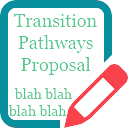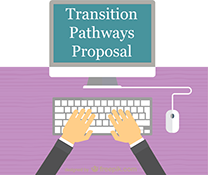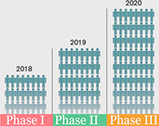Braid resources to control costs, strengthen your coalition, and ensure sustainability
December 20, 2016
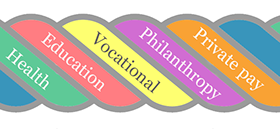 Many leaders attempting to undertake program development for the first time will assume that there is significant but untapped funding to support their efforts; public or private grants, under-utilized state or federal dollars, funds recouped through more efficient use of available dollars, potentially lucrative fees, and so on. This may have been a reasonable assumption 15 years ago, but after two decades of belt-tightening in public agencies combined with higher numbers of people seeking services, most potential sources have already been tapped.
Many leaders attempting to undertake program development for the first time will assume that there is significant but untapped funding to support their efforts; public or private grants, under-utilized state or federal dollars, funds recouped through more efficient use of available dollars, potentially lucrative fees, and so on. This may have been a reasonable assumption 15 years ago, but after two decades of belt-tightening in public agencies combined with higher numbers of people seeking services, most potential sources have already been tapped.
The model described below conveys how challenging it can be to develop alternative funding and support models, and so it is not surprising that many college-based transition programs fund themselves primarily through tuition charged to students. In many cases, the total cost is $6 000 to $10 000 above and beyond the tuition charged to a typical matriculating students. These costs put most college based programs beyond the reach of all but the wealthiest families, even for Comprehensive Transition Programs that make students eligible for federal financial aid.
 In this piece, I describe a lesson offered by the Transition Pathways Proposal for those seeking to developing multi-agency collaboratives: weave funding, staffing, and training across all of your partner agencies to control costs, ensure sustainability, and strengthen your coalition. This can help make best use of existing and new sources, and guide the selection of opportunities for program growth and improvement. Used creatively, this approach may also help to demonstrate from the outset how to improve access to these programs for families with limited incomes; a primary goal for ourselves and our funders. The creation of a braided funding and support model that carefully aligned different funding sources to direct services and program development was an important breakthrough that, if successful, would demonstrate a specific role for philanthropy in incubating program development during the start-up phase of a new university-community collaboration.
In this piece, I describe a lesson offered by the Transition Pathways Proposal for those seeking to developing multi-agency collaboratives: weave funding, staffing, and training across all of your partner agencies to control costs, ensure sustainability, and strengthen your coalition. This can help make best use of existing and new sources, and guide the selection of opportunities for program growth and improvement. Used creatively, this approach may also help to demonstrate from the outset how to improve access to these programs for families with limited incomes; a primary goal for ourselves and our funders. The creation of a braided funding and support model that carefully aligned different funding sources to direct services and program development was an important breakthrough that, if successful, would demonstrate a specific role for philanthropy in incubating program development during the start-up phase of a new university-community collaboration.
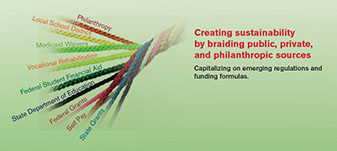 Supporting Direct Services
Supporting Direct Services
Direct services usually represent the single, most significant ongoing cost, and so are rarely the best use for time-limited grant and gift funding. Unless there is a significant policy change that specifically frees up new funds for direct services (like WIOA, or autism insurance), program improvement initiatives should be based on the assumption that services will remain at the same funding levels. For programs with budget caps based on overall enrollment rather than a per-person rate (e.g., waiver versus special education), growth might need to be tied to the number of people served. I utilized several strategies to increase direct services for the Transition Pathways Proposal, and sought to rely on public funding as much as possible to help make the program sustainable and accessible.
Increase flexibility of existing funding
I looked for flexibility in using existing sources not yet fully tapped. I was excited by a series of agreements negotiated by the DREAM Partnership with state agencies. These agreements allowed services provided in the college transition program at Millersville University to be reimbursed using existing public waiver and vocational rehabilitation funds. These agreements re-aligned the types of services provided by college-based staff with the categories of eligible expenses. These kinds of agreements underscore how collaborative networks multiply the reach and impact of new service and training initiatives.
Make better use of natural supports
I looked for opportunities to shape natural supports to function as a proxy for increased direct services - in this case, utilizing peer mentors and co-workers to support generalization of skills acquired through traditional individual and group teacher-led activities. There are associated program development costs - peer mentors and co-workers require training and coaching to be most effective. I also anticipated that we would seek to re-invigorate the peer mentor program already established at Drexel to increase the recruitment (for example, by assigning course credit for peer mentoring).
Create community-based sites to increase access
I immediately considered an earlier lesson about the advantages of creating new, community-based sites; in this case, the increased opportunities for employment internships and peer interaction that would result from a site located on campus. From the outset, I framed the partnership with high school programs as one involving a Drexel-based satellite of the school program. This proved to be critical, as it immediately limited the number of public school partners to those who had the capacity to locate 1-2 classes on site. This earlier lesson also helped me to establish the minimal critical mass of students and staff needed to efficiently support students, and led me to recommend that we aim to support two classes of 8 students each with one teacher and one assistant assigned by the school.
Streamline existing services
It is always worthwhile to consider how to make existing services more efficient - by eliminating duplicative services or activities to do not contribute directly to program goals, and so on. One important step is to optimize the amount and type of staffing support needed by creating a schedule that carefully maps activities by intensity and expertise required.
Other considerations are also important. For example, many high school programs continue to emphasize traditional academic skills during the transition, even for students not destined to meet traditional graduation requirements. The pressure to ensure academic content leads teachers to ignore critical personal, work, and community skills. Identifying these kinds of opportunities is challenging unless you have a leader with broad experience in curriculum design and program management. Exploiting these opportunities is also challenging unless you can build the kind of relationship with a school district partner in which these changes can be discussed.
I had anticipated that the success of the Transition Pathways Program would smooth later discussions about other program changes in the school district. I had hoped that other training activities for Transition Pathways could be opened up for other teachers in the district, to help them to see the benefits of focusing on personal, work, and community skills, and of adopting more work- and community-based goals. Over time, I hoped that this shift in emphasis would begin to occur 2, 3, or even 4 years before graduation, at least in the pipeline of high school schools feeding Transition Pathways, and perhaps among the broader cohort of school district teachers and programs who we engaged in our professional development program.
Identify new funding sources
I looked to capitalize on the limited new funding available - in this case, increased vocational rehabilitation dollars made available via WIOA.
Consider a specific role for philanthropy
While grants are not an appropriate source for ongoing funding of direct services, they can play a role in exploring changes in services during a program development phase. In the overall funding model for this program, I was comfortable allocating gift funds to specifically support new interventions during the development phase; for example, I anticipated that activities related to person-centered planning and self-advocacy training would be largely led by staff hired via the grant. I also utilized gift funds to pilot the benefits of paying some peer mentors to see if this might help us to retain experienced peer mentors.
Supporting Program Development
Gift and grant funding is best suited to supporting program development, for several reasons. Service organizations will always trim program development costs first, and so they are poorly positioned to invest intensively in significant expansion or improvement. Program development is also an attractive option for funders because the most significant commitment is short-term. Yet the time and resources needed to undertake comprehensive program development is always underestimated. And program development proposals for community-based programs can be difficult to sell to a funder because there is not a body of research to which these can be tied, and because most people underestimate the costs of doing it well. For this proposal, I conducted detailed analyses of program development needs to support the expected costs, and to help plan how responsibilities would be allocated across team members.
Exhaust existing grant programs for specific program development needs
We were successful in obtaining funding from the DREAM Partnership, anticipated at $180 000 over three years, to cover a range of program development activities (I hope that other states will be able to replicate DREAM's innovative funding model). During the feasibility study, we also discovered that the Pennsylvania State Department of Education would consider matching some of the costs that school districts incur in offering college-based transition programs. I was optimistic that these could cover a significant proportion of tuition fees.
Extend existing supports
As part of the long-term planning for each of the program development initiatives launched via the Transition Pathways Proposal, I considered whether an existing resource might eventually assume responsibility for coordination and oversight, after 5-6 years of operation. In each case, I felt confident that our partners (i.e., community-based agencies or designated departments within Drexel) could maintain the program, if a position were create to provide overall coordination for Transition Pathways, and partners agreed to participate in a coordinating committee.
Consider a short-term, gift-funded tuition remission program
Students in our College Pathway would be auditing 1-2 courses each semester, and university policies regarding fees for auditing courses varied widely from program to program. We also recognized that there may be additional, non-tuition fees, especially for those students in the College Pathway. Until the proposal was funded, I was not in a position to establish what additional fees the university might elect to charge. I therefore set aside in the grant proposal $8 000 in tuition fees per student in the College Pathway, until a final fee structure could be determined.
Identify a time-limited role for philanthropy
We incorporated all remaining program costs into the funding proposal to the foundation, including an indirect service rate (for this proposal, 15% of total grant costs). Philanthropy was ideally suited to this role; given that other grant sources usually include specific restrictions that can be difficult to juggle when multiple grants are combined, philanthropy usually offers more flexibility to fill in the gaps. I believe that the flexibility philanthropy offers can also be a disadvantage, inviting proposals that are much less specific in their goals and pathways to success. In this case, my experience launching related programs helped me to provide specific details about the most significant gaps philanthropy might help to fill; namely, the need for an experienced team to deliver training, coordination, and oversight over period of 5 years. These details, set within a braided model for funding and other resources, can create a much more compelling proposal for potential funders.
Related Content
On this site
 Make your case for the investment required to launch a new program by reporting per-student costs separately for each phase of long-term planning and support
Make your case for the investment required to launch a new program by reporting per-student costs separately for each phase of long-term planning and support
Because the funding model for this kind of program is complicated, it is very important to express overall costs and costs calculated on a per student basis during each phase. I outlined a funding model that showed how per-student costs associated with direct services and program development would shift over time in important ways.
Calculate costs per student: The strategic increase in the number of students served helps to dramatically decrease the per-student program development costs with each successive phase of the project that creates new capacity.
Separate costs for program development from direct services: When considered relative to the projected school district and vocational rehabilitation costs for direct services, the per-student program development costs are very high, but become much more reasonable by the end of the project. This is important when developing a plan for sustaining ongoing program development costs beyond the term of the grant.
Calculate costs separately for each phase: Investment in program development is most significant during the launch phase, and so a casual scan of the total costs relative to the number of students served can be misleading when projecting long-term costs. One reason that I sought to launch in the program in September 2016 was to bring down the per-student cost n the initial phase.
Adjust for the different supports and funding available for each Pathway: For example, a college pathway will have to accommodate some course-related fees.
Adjust for the different supports and funding available for each year: For example, public school funding and support is not available in the 2nd year of the program in the Transition Pathways Proposal.
Build in a flexible end-date: I outlined program goals for a 6th or even 7th year, depending on the extent to which university tuition fees could be reduced or covered by other sources sources. Outlining goals for a 6th or 7th year provided added incentives to control tuition costs.
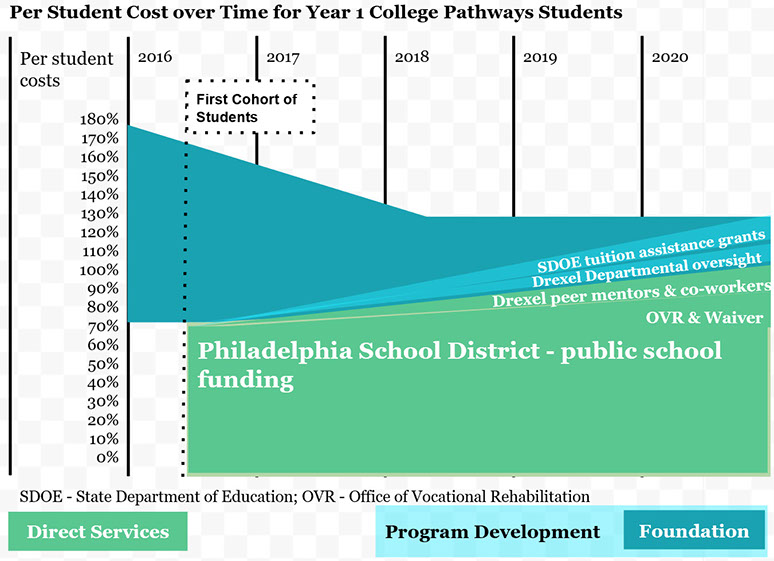
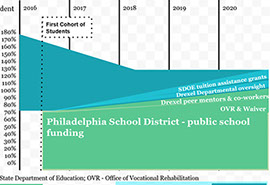
Figure: Braided Funding Over Time Per-Student
Guideposts
![]() Straight Lines Barriers to accessing services are well-established: include under-served groups from the start when testing a new service
Straight Lines Barriers to accessing services are well-established: include under-served groups from the start when testing a new service
![]() Simple Steps Creating right-sized satellite sites increases overall capacity, improves access, and sets the stage for program replication.
Simple Steps Creating right-sized satellite sites increases overall capacity, improves access, and sets the stage for program replication.
![]() Other Lessons With long-term planning and support, a university can incubate new programs of services and training for the community
Other Lessons With long-term planning and support, a university can incubate new programs of services and training for the community
![]() Other Lessons Collaborative networks multiply the impact of new initiatives when they carefully draw on the strengths of each partner
Other Lessons Collaborative networks multiply the impact of new initiatives when they carefully draw on the strengths of each partner
![]() Other Lessons Optimize the amount and type of staffing support needed by creating a schedule that maps activities by intensity and expertise
Other Lessons Optimize the amount and type of staffing support needed by creating a schedule that maps activities by intensity and expertise
X
